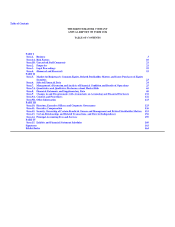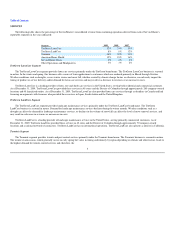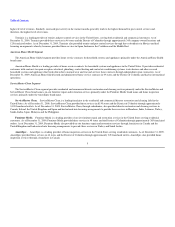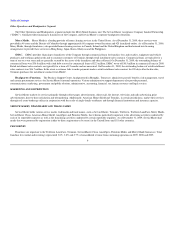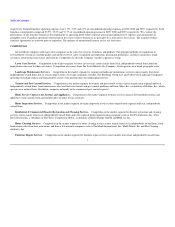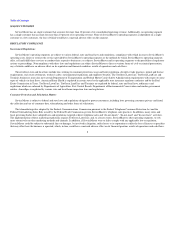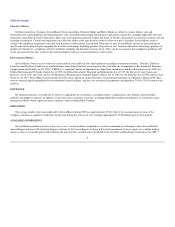American Home Shield 2009 Annual Report Download - page 14
Download and view the complete annual report
Please find page 14 of the 2009 American Home Shield annual report below. You can navigate through the pages in the report by either clicking on the pages listed below, or by using the keyword search tool below to find specific information within the annual report.
Table of Contents
business if we cannot travel to service locations due to hazardous road conditions. In addition, severe temperatures can lead to an increase in service requests
related to household systems and appliances in our home service contract business, resulting in higher costs and lower profitability.
Our market segments are highly competitive. Competition could reduce our market share and adversely impact our results of operations.
We operate in highly competitive market segments. Changes in the source and intensity of competition in the market segments served by us impact the
demand for our services and may result in additional pricing pressures. The relatively low capital cost of entry to certain of our businesses has led to strong
competitive markets, including regional and local owner-operated companies. Regional and local competitors operating in a limited geographic area may have
lower labor, benefits and overhead costs. The principal methods of competition in our businesses include name recognition, quality and speed of service,
pricing, customer satisfaction and reputation. No assurance can be given that we will be able to compete successfully against current or future competitors and
that the competitive pressures that we face will not result in reduced market segment share or negatively impact our financial position, results of operations
and cash flows.
Increases in raw material prices, fuel prices and other operating costs could adversely affect our results of operations.
Our financial performance is affected by the level of our operating expenses, such as fuel, fertilizer, chemicals, raw materials, wages and salaries,
employee benefits, health care, vehicle, self-insurance costs and other insurance premiums as well as various regulatory compliance costs, all of which may be
subject to inflationary pressures. In particular, our financial performance is adversely affected by increases in these operating costs. In recent years, fuel prices
have fluctuated widely. Sharp increases were experienced in 2007 and 2008, which raised our costs of operating vehicles and equipment. Fuel price increases
can also result in increases in the cost of fertilizer, chemicals and other materials used in our business. We cannot predict the extent to which we may
experience future increases in costs of fuel, fertilizer, chemicals, raw materials, wages, employee benefits, healthcare, vehicles, insurance and other operating
costs. To the extent such costs increase, we may not be able to fully pass these increased costs through to our existing and prospective customers, and the rates
we pay to our subcontractors may increase, any of which could have a material adverse impact on our financial position, results of operations and cash flows.
Our future success depends on our ability to attract and retain trained workers and third party contractors.
Our future success and financial performance depend substantially on our ability to attract, retain and train workers and attract and retain third party
contractors. Our ability to conduct our operations is in part impacted by our ability to increase our labor force including on a seasonal basis, which may be
adversely impacted by a number of factors, including a failure of the U.S. Congress to reauthorize the returning worker exception to the H2B Visa Program,
which may negatively impact the number of foreign nationals available to engage in seasonal employment. In the event of a labor shortage, we could
experience difficulty in delivering our services in a high-quality or timely manner and could be forced to increase wages in order to attract and retain
employees, which would result in higher operating costs and reduced profitability.
We may not successfully implement our business strategies or realize all of our expected cost savings.
We may not be able to fully implement our business strategies or realize, in whole or in part within the time frames anticipated, the anticipated benefits
of our various initiatives, such as our
12


